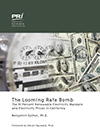San Francisco The Pacific Research Institute, a free-market think tank based in San Francisco, released a new report today that finds that Californias 33 percent renewable portfolio standard (RPS) will impose upon the state in 2020 an aggregate marginal economic cost of about $5 billion in year 2011 dollars. Signed into law by Governor Jerry Brown, the legislation requires that by 2020, California electric utilities obtain 33 percent of their power supplies from such nonhydroelectric renewable sources as wind, solar, and geothermal technologies. The Looming Rate Bomb: The 33 Percent Renewable Electricity Mandate and Electricity Prices in California by PRI senior fellow, Benjamin Zycher, Ph.D., is available HERE.

Current estimates of the cost of this requirement are too low by a substantial amount, largely because of underestimated costs for transmission, backup capacity, and generation, said Dr. Zycher. A more realistic estimate of the cost of the California renewables requirement is approximately $5 billion in 2020, and rising thereafter. The table below summarizes the breakdown:
Marginal Cost of the California 33 Percent RPS in 2020
(millions of year 2011 dollars)
Transmission 941.6
Backup 550.0
Generation 3500.0
Total $4991.6
According to Dr. Zycher, the $5 billion cost of the RPS requirement in 2020 is an implicit tax of 27 percent relative to the generation and transmission costs of projected consumption in 2020 were it to be produced with the electric generation technology mix of 2012. Moreover, this implicit tax to be imposed upon the California economy will grow each year as the size of the electricity market expands and the RPS requirement forces ever-greater amounts of high-cost power onto the market. Over the longer term, this cost effect will increase proportionately with power consumption unless there is a decline in the relative cost of renewable power, a prospect for which there is little evidence in the cost trends, and which is highly unlikely given current and prospective prices for natural gas, Dr. Zycher said.
This perverse effect inexorably will be reflected fully in rising rates paid by consumers, whether directly or indirectly, said Dr. Zycher. Rates and other costs borne by consumers, taxpayers, businesses, and other parties—ultimate consumer costs—must cover the marginal cost of the RPS mandates, even if those costs are hidden in part with various subsidies and other policy tools. Consumer costs in 2020 will rise by over 13 percent—in real terms as a result of the 33 percent RPS requirement.
Dr. Zycher added that California power rates are very likely to rise by almost 20 percent even in the absence of the costs imposed by the 33 percent RPS requirement, due to the prospective need for various capital investments driven by both economic and regulatory factors, and by the California cap-and-trade program mandated by the 2006 Global Warming Solutions Act. Accordingly, the extra costs to be imposed by the 33 percent RPS requirement will exacerbate those cost increases that largely are independent of the RPS requirement itself. Californians between now and 2020 will be confronted with an overall increase in power prices and costs of approximately 33 percent. The table below summarizes these effects:
Components of Prospective Rate Increases for California
Source Rate Increase (percent)
Capital Investment:
economic, regulatory 16.7
33 Percent RPS Mandate 13
Cap-and-Trade Costs 3
Total 32.7
For all sectors, California retail rates are 93-131 percent higher than those in the Pacific Northwest, and 70 percent higher than those in the Mountain region. They are 53 percent higher than those for the U.S. as a whole, a figure biased downward by high costs for Alaska and Hawaii and by the inclusion of California rates in the average figure for the U.S. Rates in other states and regions may rise as 2020 approaches, but the 33 percent RPS requirement in California is very likely to increase rather than reduce the states relative price disadvantage.
Dr. Zycher concludes: This adverse effect is certain to worsen the other important disadvantages that various California public policies have created in terms of competitive dynamics with other states.

